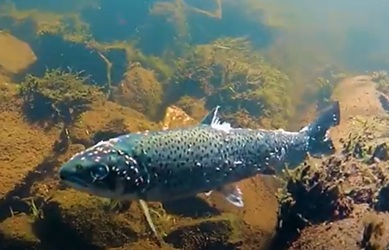Games theory: A recent commentary from Manolin Norway reported in Salmon Business, together with news from another of Salmon Business’s reports about stakeholder’s views on regulation demonstrate that changing the focus of data can mean that the original intention gets lost and almost forgotten.
Manolin say that Norway’s sea lice pressure shows a familiar pattern in 2025 to that of previous years although this year the scale of the pressure is said to be much higher. They say that during the first half of the year, monthly counts were consistently higher than in 2023. They use June as an example with female lice reaching 63 million in 2025 compared to 51 million in 2023, an increase of 23% whilst March was 73 million compared to 64 million. Manolin suggest that this higher baseline means that farms are under more pressure from lice than they were two years ago.
Manolin continue that the difference becomes even more striking at the seasonal peak with female lice reaching 136 million in August which is similar to that of 2024 but 80% higher than in August 2023 with 75 million lice. At the same time, mobile lice surged to 429 million in August this year compared to 365 million in 2024 and 245 million in 2023. They say that combined, both female and mobile lice pressures are dramatically higher than in 2023.
I suspect that those with a more generalised knowledge of sea lice may get extremely worried by these figures, but they are a good example of how issues are hyped up beyond their scope.
Firstly, sea lice management regulations are imposed not to protect farms but supposedly to protect wild fish stocks and prevent their continued decline. The key time of potential concern is when salmon smolts migrated from their rivers to the sea during the spring months. It can be seen from the Manolin graph, that their calculation of lice numbers is low at that time. When Manolin show that lice numbers are at their peak during the autumn months, the salmon smolts have long gone and it is the large salmon heading back to the rivers that are prevalent. As these fish enter the freshwater rivers, any lice will drop off. Equally, there is no evidence that sea trout suffer more at this time than at any other time.
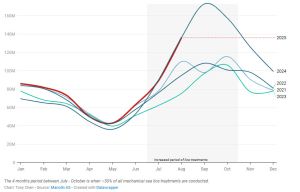
Manolin also suggest that high lice counts on one farm may threaten the fish at nearby farms but again, this is more conjecture that evidence. Most farms are infected by other means than high lice counts at nearby farms. I would highlight the most contentious salmon farm in Scotland, the now closed farm at Loch Ewe whose sea lice are said to have been the cause of the collapse of Loch Maree sea trout. The Loch Ewe farm was 55 miles from the nearest farm in one direction and 40 miles from another in the other direction. Loch Ewe was clearly never infected with sea lice from another farm.
The second point is that we already know, relying on modelling about sea lice is like entering unknown territory. This is because the approach taken by the scientific community is extremely simplistic. Measurement of sea lice levels on salmon farms relies on sampling 10 to 20 fish out of the 100,000 plus fish that are typically stocked. Measuring larger samples is a risky business on a regular basis because disturbing the fish and then handling some can lead to stress and open routes to secondary infections. Ten fish out of 100,000 cannot be judged to be truly representative, especially when it is easier to catch infected fish than the healthiest.
The small sample is then extrapolated to the whole pen so using an example from IMR dated September 2024 in which they say that if the sample shows a level of 0.5 adult female lice the pen will have 50,000 adult female lice in total.
Manolin have then extrapolated the sample to the whole Norwegian biomass to arrive at the 136 million female lice calculated for August this year.
Unfortunately, as I have suggested, this is simplified maths rather than the reality of parasite biology. I have previously talked extensively about how parasites are distributed amongst their hosts. This means that most hosts have no parasites, and a few have many. I have discussed this with some veterinary specialists, and they agree from their observations that lice are not spread evenly throughout the pens. I am hoping that new AI will be able to confirm this spread in future but until then the only way to be sure is to examine every fish in a pen, which is not going to happen for a variety of commercial and practical reasons. However, parasite ecology is parasite ecology and I have no reason to expect sea lice in salmon pens to be any different, although I suspect that if left untreated for long periods, the spread of lice in a pen may change, Again, I cannot see any experiment ever taking place to see what happens simply for welfare reasons.
My view is that based on small samples and aggregated distributions, the estimates of total sea lice numbers are highly exaggerated. In addition, the 2024 van Nes paper has further questioned estimates based on lice viability. Clearly if the numbers are exaggerated, then so is the predicted egg production, which is why research has failed to find infective sea lice larvae in the numbers predicted by the various sea lice models.
Unfortunately , sea lice research appears to have become dependent on models rather than reality and it seems that it is the real-world science that the established scientific community wish to avoid.
Meanwhile, in their latest commentary as reported by Salmon Business, Manolin have tried to apply Games Theory to their models and estimates. It is worth stressing the word ‘Theory, in this context. Manolin say that they have extended the models to include the price of salmon as they see this as a driver of farm management process. Currently, they say that with tighter margins, farms are under pressure to reduce costs and delaying sea lice treatments are a way of reducing costs. They add that whilst the number of treatments have increased, they are shorter, smaller and more frequent. With an eye on costs, Manolin suggests that the instinct is to delay or reduce treatments however, the higher the lice counts before treatment mean that the treatments become less effective.
Manolin also suggest that the decision process on when to treat is akin to the Prisoners Dilemma in Games Theory where farms might consider delaying treatment in the hope of better timing, but that early treatment might improve the situation for other local farmers.
I would argue that this is overthinking the sea lice issue and that farmers would treat when health care professional say that there is a need to. Unfortunately, government regulations have been based on the idea that sea lice are responsible for the dire state of wild fish populations, and this is why sea lice levels need to be kept so low.
Sadly, when it comes to sea lice, the narrative is being dictated by unconventional ideas and models rather than on actual science and evidence, I would suggest that this is not a game but the reality.
Same old: In the last issue of reLAKSation, I discussed the German documentary about the state of wild salmon in Norway. Something else I am doing prompted me to take another look at the video and it occurred to me that Alv Arne Lyse of the Norwegian Hunters and Fishers Association had previously come to my attention.
Regular readers of reLAKSation may remember that an early focus of my interest in sea lice was the claim by the anglers’ groups that salmon farming was responsible for the demise of the world-renowned sea trout fishery in Loch Maree. Although the alleged collapse of the fishery occurred in 1988 and a paper was not published about it until 2006, Wild Fish in their previous incarnation of Salmon & Trout Conservation produced a video about Loch Maree as late as ten years ago. More recently, Loch Maree has fallen off the radar because following the closure of the Loch Ewe farm, sea trout numbers have failed to improve as the wild fish organisations claimed they would. At the same time, wild salmon numbers which were relatively good have significantly declined.
Anyway, I was taking another look at the S&TC video (https://www.youtube.com/watch?v=4_dfbbkkVjs) and it was the credits that this time caught my attention.
I remember that I have made this point previously but the images in this video about the sea trout of Loch Maree were all supplied by Mr Lyse and his colleagues at the Hunters and Fishers Association. The fish were all filmed in Norway. Clearly, those watching this video have been misled by Wild Fish/ S&TC as the fish portrayed had nothing to do with Loch Maree.
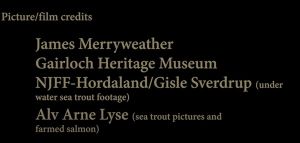
One of the images in the Loch Maree video is of a single sea trout which is badly infested, something which can be entirely natural especially in just a few fish.
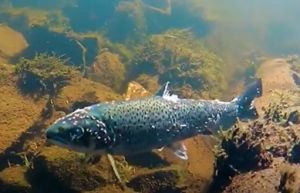
Meanwhile, the German video includes the following commentary:
‘On his laptop, Alv Arne has an extraordinary video. On a fishing trip with some schoolchildren, he discovered trout whose skin and fins had been completely destroyed by salmon lice. The parasite attaches itself to the fish and eats its way inside’.
He showed a video from which the following screen shot is taken.
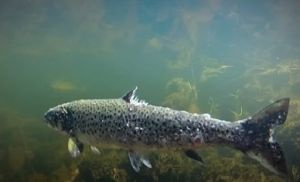
I cannot be 100% certain but this looks to be the same fish. The background looks to be the same and of course Alv Arne Lyse and the Hunters and Fishers Association is common to both.
The Loch Maree video is around ten years old, which makes this image about ten years old too. Yet, this ‘extraordinary’ video also appears in a documentary that was first aired in recent weeks. Perhaps the most extraordinary aspect to the image is that the Hunters and Fishers Association have nothing more recent to show the filmmakers.
It seems to be a feature of those who oppose salmon farming to use the same photo repeatedly rather than collect relevant imagery for the locations they are campaigning for. I am reminded of the famous young salmon from British Columbia that has appeared as support for many anti-salmon campaigns even described as being of different species. It seems that just one image is sufficient to make exaggerated claims against salmon farming.
I would like to end this section with an image taken by Wester Ross Fishery Trust in 2012. This shows a sea trout infested with 120 chalimus lice caught from a nearby river system to Loch Maree.
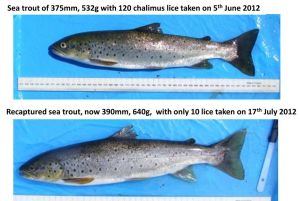
The fish was subsequently released but recaptured just over a month later. It had grown from 375mm to 390 mm and had increased its weight from 532g to 640g. However, of most interest, the sea lice count had fallen from 120 to just 10. It seems that high numbers of lice are not an obstacle to growth but more importantly, fish can also shed their parasitic load.
I would be interested to hear what the Norwegian Sea Lice Expert Group have to say about this fish.
Run Balmoral: The Fisheries Management Scotland (FMS) website carried a news story dated 15th September about the Run Balmoral event. About 5,000 runners turned up to complete various distance races over two days. This year rather than give out event T-shirts, the organisers donated £5,000 to the River Dee’s One Million trees campaign, which aims to plant trees across the River Dee catchment.
Whilst happy to promote this generosity, FMS appeared to have missed a major news story that was published in the Scotsman newspaper the previous day. This was that an investigation has been launched after nearly 200 wild salmon have been found dead in the River Findhorn near a site where the A9 trunk road is being converted into dual carriageway. The fish had been electro-fished and moved to a different location. The road contractors Balfour Beatty subsequently reported the fish deaths to SEPA who are conducting the investigation. SEPA have said that the fish did not die during the electro-fishing procedure but that an investigation is being carried out to ascertain why the fish died.
It would be really surprising if Balfour Beatty had been involved in the fish transfer directly because it is usual for contractors of infrastructure works to use specialists to undertake any environmental work whether it be for fish or terrestrial animals. Those involved in electro-fishing work must be licensed by the Scottish Government and typically, this would be the local fishery trusts, as this electro-fishing is part of their usual activities. I have no idea whether the local fishery trust was involved in this incident, and I am not suggesting that they were, but electro-fishing and fish transfers are two very different things. It is surprising that the Scotsman article has not sought to uncover who was actually involved in the process. Unfortunately, the article focuses on the contractor, and any reader might think that they were responsible when it is unlikely that they were.
The deaths of 200 migratory fish, irrespective of their size – these were probably juveniles – is a major issue. It is surprising that the news has received so little coverage especially from Fisheries Management Scotland who seem to be more interested in the fact that one of their members received a significant donation enabling them to plant more trees than the deaths of so many young fish.

